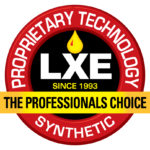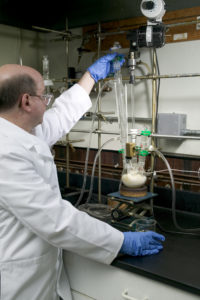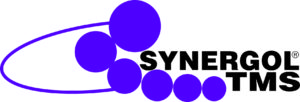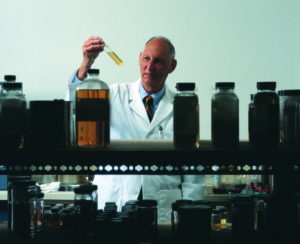Lubegard Technology
LXE® Technology

Since 1984, International Lubricants, Inc. has been a leader in researching, developing, and manufacturing patented high-performing ester-based synthetic lubricants and related products for automotive, industrial, marine and agricultural applications. It started here, during the preliminary development of the company’s proprietary LXE Technology, that International Lubricants Inc. took the opportunity to manufacture products that were friendlier to the environment, benign in their affect on users, and superior at resolving many common fluid-related difficulties.
Dr. Phil Landis, former head of Mobil Oil Applied Lubrication Research Group, became an automotive industry tribology pioneer through his formulation of the LXE, Liquid Wax Ester, Technology as a direct molecular replacement for sperm whale oil.
Why sperm whale oil?

Sperm whale oil and its derivatives were used as additives in virtually all automotive lubricants. The products were so effective that vehicles’ fluids were generally never
changed, and systems like the transmission lasted the life of the car. Some 30 million pounds of sperm whale oil were used every year in lubricants alone. To supply the demand, hundreds of thousands of whales were harvested bringing that species to the brink of extinction.
In 1972, the Endangered Species Act outlawed the killing of whales and the use of materials derived from those animals. For years, in engine oils, the automotive industry relied on other animal based products such as tallow or lard. For complex systems such as transmissions, these substitutes proved to be inadequate, leading to poor overall drive train performance, premature drive train failure and failure due to heat. For instance, automatic transmission failures went from less than a million units in 1972 to over eight million units a year by 1975, due to the loss of sperm whale oil additives. According to the Automatic Transmission Rebuilder’s Association of Ventura, Calif., today, there are over 11 million automatic transmission failures per year (and nearly nine out of ten) are caused by the degradation of automatic transmission fluid due to heat. Heat promotes the oxidation of transmission fluid, and that compromises its performance and accelerates wear on the internal components of automatic transmissions.
Formulating LXE, a direct synthetic replacement to Sperm Whale oil
Liquid Wax Ester (LXE®) was first developed and patented as a synthetic replacement for sperm whale oil. The structure and performance of LXE is similar to that of natural sperm whale oil, and is one of the world’s largest known ester chains. The synthetic ester has a structure that binds the molecules together tightly, thus allowing flow at low temperatures while maintaining oxidative stability. Because it has very little unsaturation, it is much more stable than many other synthetic molecules.
So how, exactly is LXE made? Glad you asked.
LXE Technology is bio-based, and composed of the fatty acid of a high erucic acid containing seed oil esterified with an expensive and rare alcohol. The process demands that we use the highest purity essential oils, with long fatty chain triglyceride ester groups and with little or no unsaturation (which if present, would lead to oxidative instability).
Some LUBEGARD products with LXE Technology also use a phosphorous material, whereby the compound reacts at metal surfaces and forms a strong bond, great for use as an anti-wear additive and friction modifier which is also very effective and efficient for slow sliding speeds.
An organic sulphur compound is also used in various products. This is what gives the distinct odor of some LUBEGARD Products. The phosphorous-sulfur combination enhances the anti-wear properties of the phosphorus for additional performance and protection. The esters serve as a lubricant and an antioxidant, which prevents air from reacting with hydrocarbons and converting them to sludge and dirt.
And of course, the LXE molecule and its’ derivative molecules are then incorporated into various functional formulations or products that are perfect for industries such as automotive, marine, power equipment, essentially any motorized system where heat, oxidation, wear, and acid buildup could occur.
Interestingly enough, ILI’s unique synthetic LXE Technology is proven to actually outperform the sperm whale oil additives. Independent third party testing by OEM fluid laboratories prove LXE Technology reduces component wear by at least 50%, reduces oxygen uptake, which leads to oxidation by 30% and reduces pentane insolubles (sludge) by 60% when added to GM® factory fill. (Reference oil for DEXRON® approval).
The Unique Difference
It’s at the molecular level that lubricants are different. Blending of various components allows their molecular structures to translate to the characteristics needed to fight oxidation, heat build-up, converter chatter, etc. LXE functions primarily to remove heat from frictional surfaces which can see surface
temperatures in automatic transmissions of more than 300 degrees Fahrenheit. LXE absorbs the heat from internal metal surfaces and transfers that heat to the outer metal surface where it is dissipated.

Removes Heat
LUBEGARD esters are most famous for their “heat sink” abilities. Heat sink is the absorption of heat generated at frictional surfaces, such as gears, or gear teeth into the oil phase. In mechanical systems, heat is absorbed from the frictional surface through the bulk oil (whether it’s synthetic or mineral), and is carried to and discharged through the container walls. For example, in an automatic transmission, the heat is carried and discharged to the outer metal housing and cooling system. When two metal surfaces come in close contact, they compress the oil molecules between the metal surfaces at the metal-oil interface. The friction generated at that interface generates heat (just like when you rub your hands together – you feel frictional heat on your skin). When LUBEGARD LXE®(Liquid Wax Ester)Technology is present in the oil, its molecules are adsorbed onto the internal metal surfaces soaking up the heat and transferring it to the bulk oil from the metal surfaces. The oil and LXE molecules containing the heat are then dispersed to the external metal housing where it is dissipated to the atmosphere (surroundings). Other competing additives can actually trap in excess heat in critical functional areas – likely resulting in failures.
Superior Lubrication
HYDRODYNAMIC LUBRICATION: Lubrication systems where moving surfaces are actually separated by an oil film, preventing all metal contact. This is also referred to as “full film” lubrication. In other words; when metal surfaces do not ever touch each other. In a mechanical assembly the viscosity of the fluid impacts the fluid film. That’s why using the right additive is crucial! The movement of metal surfaces creates friction between the surfaces. LXE molecules actually REMOVE the heat and transport it to the outer core, thereby shielding, or protecting the internal components.
BOUNDARY LUBRICATION: Conditions that do not permit the formation of lubricant film. In other words, areas where surfaces actually touch. As in metal to metal contact.
The molecular makeup of LXE Technology provides a very long chain of carbon atoms and contains carbon-oxygen bonds. The oxygen atom is strongly attracted to metal surfaces. Advantageously, when the LXE molecules are heated in internal critical components, the release of the atoms carry the heat outward in a spiral centrifugal force (similar to spinning a toy top in a puddle of water) and transfers it harmlessly to the outer metal case. LUBEGARD LXE molecules actually attach to the metal surfaces – and then are released (instead of scraping or scoring the metal) and instantly reform again, then are released again, reforms, released again and continues to reform/release indefinitely.
The Unique Results
- Only LXE Technology has been approved, endorsed, recommended and used by OEM’s.
- LUBEGARD products with LXE Technology have eight service bulletins from the OEM’s, which tell their dealerships to use a specific LUBEGARD product to fix a specific problem. There is no other competing product that can make that claim.
- LUBEGARD products are currently recommended and endorsed by the largest transmission repair chains: AAMCO®, Cottman® and LeeMyles®.
- LUBEGARD has been awarded the most TOP SHOP PRODUCTS and TOP TOOL Awards by professional transmission technicians year after year.
- ILI was awarded the prestigious ‘Product of the Year’ award for its proprietary LXE Technology from Lubricants World.
ILI’s ground-breaking research has led to research grants in excess of $2 million from the U.S. Department of Agriculture, the Department of Defense and the Soy Bean Board. Today, LUBEGARD Automatic Transmission Fluid Protectant is the number one product used in the professional transmission rebuild industry, and the only product of its kind to be used and approved by major automobile manufacturers (OEM’s).
International Lubricants, Inc. has been granted a total of over 100 U.S. and foreign patents and their research efforts ensure that they remain on the cutting edge of new product development and product improvements.

For Non-sacrificial anti-wear/lubricity without phosphorous, halogen, sulfur, or acids
Synergol TMS uses the same unique chemistry as Synergol FLA but on an oxidatively stable backbone to allow its use in many forms of lubrication. It has the immediate potential to replace or reduce the amount of zinc dialkyldithiophosphate (ZDDP), phosphorous, chlorine or other active-boundary-layer materials in lubricant fluids. Reducing the levels of these active ingredients makes the lubricants more stable and less prone to developing corrosion issues and harmful sludge.
This is the direction in which all extended-life lubricant formulations are headed.
Synergol TMS is an extended-life anti-wear material, because it is not consumed like sacrificial phosphorus and other reactive anti-wear additives that are in today’s lubricating systems.
This material has enormous potential for immediate application in future lubricant systems.
It lasts longer and works with common Anti-wear and Extreme Pressure Additives without the typical competition for the metal surface, while at the same time reducing your environmental exposure risk.

A New Paradigm in Biodegradability with Performance
The ERUCiCHEM® name of International Lubricants, Inc.’s division of agricultural (oil) based products was conceived from the free acid name of erucic acid. Erucic acid is produced by the hydrolysis of its’ corresponding triglyceride ester, which is present in some agricultural oils.
In addition to having developed agricultural based lubricant products for general industrial applications, the ERUCiCHEM Division of International Lubricants, Inc. has also developed unique lubricant products for such diverse industries as cosmetics, automobile and metalworking.
International Lubricants, Inc.’s introduction of agricultural based products as replacements for traditional hydrocarbon based lubricants has resulted in the introduction of three groundbreaking patented and proprietary lubricant technologies – Liquid Wax Esters (LXE®), Synergol® Lubricity and Anti-Wear Technology and a completely bio based and natural polymeric telomer for cosmetic applications, which is sold under the trade name of Glossamer® L6600.


